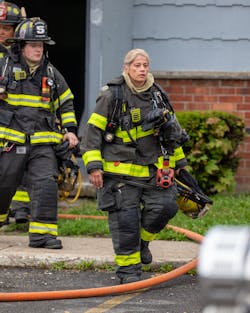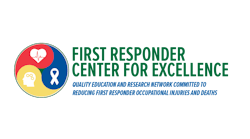Creating a Health & Wellness Program for Your Department
Firefighting is a demanding occupation. Considerable physical fitness and mental fortitude are required to perform an array of challenging tasks. The public belief is that firefighters, career or volunteer, inherently possess physical fitness attributes and mental resilience that allow them to perform their duties with energy and efficiency. Unfortunately, this perception doesn’t always match reality and, therefore, creates an apparent need for leaders to foster a cultural shift in the way of thinking and behaving when it comes to physical and mental wellness.
Health and wellness programs can be helpful instruments for this change and provide several benefits by creating a department of well-informed and well-equipped firefighters.
Little argument can be made to refute the many benefits of a comprehensive health and wellness program. Unfortunately, the common acceptance of these gains hasn’t translated into tangible changes in departments. In 2021, the NFPA produced The Fifth Needs Assessment of the U.S. Fire Service and revealed the following about our national fire service:
- 72 percent of departments lack a program to maintain basic firefighting fitness and health
- 61 percent of departments don’t provide medical and physical evaluations for all firefighters that comply with NFPA 1582: Standard on Comprehensive Occupational Medical Program for Fire Departments
- 73 percent of departments lack a behavioral health program (larger departments are much more likely to have such a program)
- 56 percent of fire stations aren’t equipped for exhaust emissions control; this number rises to 82 percent in the smallest communities
- Many departments don’t engage in cancer prevention best practices
Department leaders can begin to correct these shortcomings and establish a more healthful course for the future. As the famous Chinese proverb teaches us, “The best time to plant a tree was 20 years ago. The second best time is now.”
Implementing a well-thought-out health and wellness program that considers all aspects of a firefighter’s well-being is the first step toward supporting long-lasting changes.
Designing and managing an effective program is an important first step to improving the health and productivity of personnel, which transfers to better customer service.
Although a health and wellness program might not be popular, studies offer evidence that participation in such a program is associated with significant health-risk reductions. A study that was conducted by John White and others reviewed data from more than 173,000 health-risk assessments. The study determined that participants who followed a health and wellness program showed a reduction in 5 of 7 common health risks (blood pressure, body weight, cholesterol level, nutrition, physical inactivity, stress and tobacco use).
Senior management buy-in
Any new program is difficult to implement when departmental leadership isn’t supportive of the effort. Senior management and/or government officials influence the funding and resources that are required to plan, implement and evaluate the program. Their direct involvement also validates the importance of the program and provides the needed support for eventual inclusion in an organization’s policies, vision, mission and strategy.
An effective method to increase the chances of support is to create a business-style proposal. This proposal might outline the goals of and identify the need for the program and detail expenditures for funding to include the following:
- Employee benefits: Convey how the program might improve the condition of the workforce (for example, more productive and less stressed members)
- Employer benefits: Communicate how the program benefits the company (for example, improving workplace morale and reducing member absenteeism)
- Strategic goals: Demonstrate how the plan supports any department urgent issues (for example, boosting personnel retention and recruitment)
Health & wellness committee
The primary role of a health and wellness committee is to communicate, participate, motivate and support the program. The committee should consist of a peer group of employees who guide activities and become advocates for program participation. Ideally, the committee should consist of individuals who are from all levels of the organization and represent a cross section of department members. This ensures that all members are represented and can provide input and ideas from diverse perspectives, so the program can meet the needs of the department effectually. The committee establishes continuity, enthusiasm and ownership of the program as well as provides an excellent means of communication.
Consideration for committee selection should include determining which individuals will be most helpful to the program and what groups of individuals the program will affect. Consider appointing the following personnel/departments to the committee: senior management; union/volunteer association representatives; human resources; employee assistance program/peer support/chaplains; IT; health and safety officer; diversity of station level personnel who show interest in health and wellness.
Needs assessment
An initial priority for a newly developed health and wellness committee is to conduct a needs assessment of the department. This serves as a powerful means for decision-making, resource request/allocation and reaching programmatic goals. The assessment should concentrate on understanding actual needs of members and act as a compass for the direction, and directional change, of the program. Capturing this information is beneficial in creating a snapshot of the current health of the department and developing the goals and objectives for improvements that are based on these findings. Information might be acquired through several methods including: surveys/questionnaires; establishing a sample group; individual interviews; conducting health-risk assessments that screen employees for biometric data, such as blood pressure, cholesterol, BMI, etc.; and focus groups. Regardless of the information-collecting process, it’s important to remember that the fundamental goal of a needs assessment is to determine the current situation compared with the desired outcome. The gap that’s between these two areas creates a beginning and an end for program goals and objectives and forms the basis for determining the measurement of program success.
Goals and objectives
For many organizations, a primary goal might be to improve personnel’s health and thereby increase their ability to be physically prepared for the strenuous tasks at hand. Other goals might include reducing absenteeism, boosting employee morale and increasing retention.
Program goals and objectives should match the results of the needs analysis, consist of realistic and achievable long-term accomplishments, and illustrate the expected outcomes.
Each goal includes one or more objectives to act as a guide toward completing.
Unlike goals, objectives should be more detailed, time-limited and clearly stated in such a way that the program’s success can be measured against them.
In formulating workplace wellness goals and objectives, Matthew Grawitch and others who worked as research consultants for the American Psychological Association outlined five practices that are central to the successful implementation of a health and wellness program: work-life balance, employee safety, employee growth, employee development, and employee recognition and involvement.
Remember to meet the participants on the level they are at. This might be as simple as increasing general physical activities or reaching basic targeted fitness goals. Goals and objectives that are reflective of the members’ needs greatly contribute to the increase of participation in the program.
Establish a budget
Setting a budget helps to determine the parameters and limitations of a health and wellness program. Funding allocation is dependent on program importance, available resources and the activities that are connected to the needs analysis response.
A good starting point is to review current spending on health and wellness and determine whether these funds can be distributed differently.
If a previous budget doesn’t exist, it’s worthwhile to work with department leadership to consider reallocating funds from other areas of the budget or to put together a proposal to incorporate into an upcoming budget.
Typically, requests for funding of new programs/projects are made during a Proposed Budget process in preparation for the following fiscal year. Assistance with this process might be offered by a department’s budget/fiscal representative.
Most departments require a budget justification to explain and rationalize the expenses that are requested. A budget justification is a detailed narrative description of each component of the budget, which substantiates the cost of the proposed program. The details should explain how each budget item achieves the goals of the program and the methods of estimated costs. Government budget analysts might look for information that relates particularly to the return on investment in comparison to the requested funds. Therefore, this information should be an early focal point in your justifications.
It’s important to have proper oversight measures in place, because a health and wellness program can become incredibly expensive. By being fiscally responsible, a program is more likely to be a sustainable component of a department’s cost of business.
Program components
Creating a health and wellness program can be challenging, because a one-size-fits-all program isn’t practical, as each program will vary based on organizational needs and resources. Programs might range from inexpensive and simplistic to high-priced and elaborate. Designed components might include awareness, behavior elements and activities that target specific risk behaviors that are determined by the needs analysis. Although the program’s purpose is to meet the participants’ wants and desires, it also is important that the program is built to accomplish programmatic goals. This element will be valuable in generating tangible results for future funding requests and in providing guidance for program modifications. Examples of common program components are: health screenings/annual physicals; stress-reduction programs; nutrition education; weight-loss programs; health-risk-factors reduction; and exercise programs and activities.
Although committees might have some flexibility in designing a health and wellness program, department leaders must consider legal issues and compliance requirements that relate to HIPAA, the Occupational Safety and Health Administration, the Americans with Disabilities Act, labor agreements, local government policies, etc.
An additional consideration is to develop community partnerships to assist in the design and implementation of the program and to provide additional resources to meet needs or fill gaps that the department can’t accomplish or properly fund. This could be in the form of access to local fitness facilities, health seminars from local health professionals, educational materials from outside organizations, (First Responder Center for Excellence, National Fallen Firefighters Foundation, American Heart Association, etc.) and collaborating with local/state health departments. All outside partners should be made aware of the needs analysis results, goals, and objectives of the program and of clear expectations of their roles and responsibilities.
Being innovative in the design process and building a cooperative environment bring department members and leaders together to ensure program success.
Implementation
The implementation phase is where the written components that were developed by the committee are put into action to achieve predetermined results.
The quality of implementation plays a significant part in bringing about outcomes. If a program is implemented poorly, or even moderately well, its goals are unlikely to be achieved, or the results will be less significant. It’s difficult to overstate the importance of a well-thought-out implementation plan. It’s a project management tool that guides the program execution through the division of goal accomplishments into smaller actions while defining the timeline, responsibilities and required resources. Although it should be as comprehensive as possible, remember that implementation is a dynamic process that often involves adjustments and might involve returning to previous steps for program reevaluation. Most importantly, ensure that the program is presented in a positive, welcoming and inclusive manner. To increase the likelihood of programmatic success, key components might include:
- Define goals/objectives; specify in detail the required results; identify steps that are required for result achievement
- Allocate resources (time, money, personnel, internal and external partnerships)
- Schedule milestones; define key tasks and outcomes of those tasks; assign a value to this measurement (completion date, number of resources, etc.)
- Designate responsibilities; identify specific areas or tasks and assign them to committee members; match strengths/weaknesses of the responsibility to the potential designee
- Identify the metrics that will be utilized to measure a successful program
Communication is paramount during the implementation phase to effectively market the new program and to gain participatory interest from members. This includes utilizing internal communication channels as well as external methods to engage members in their health and well-being.
Evaluate
As with any project, evaluating the effectiveness of a health and wellness program is invaluable for management support and member engagement and for sustaining the program through revising or implementing new elements. The program should contain realistic and achievable goals to encourage individual and program success, particularly during rollout. As goals are reached, make the effort to celebrate and offer recognition to those who contributed to the accomplishments. Simple examples of evaluations can be participation rates, program completion rates, percentage of members who stopped smoking, weight reduction (individual and collectively) and reduction in targeted biomarkers.
Incorporating stakeholder engagement is important to identify early on the needs and preferences for determining what success looks like.
Regardless of the tools or measurements that are used, evaluating the effectiveness of the wellness program is important in ensuring that the needs of department members are met and results are moving in a positive direction.
ROI for a Health & Wellness Program
Return on investment benefits for health and wellness programs may benefit departments by:
- Reducing sick leave/absenteeism
- Potentially lowering health care costs
- Reducing injuries
- Reducing workers’ compensation and disability-related costs
- Improving on-the-job performance
- Increasing employee morale and engagement
- Improving recruitment and retention
Alternative Health & Wellness Program Funding
Funding for a fire department health and wellness program often must be sought via the typical budget process. Additionally, a health and wellness committee might want to search for alternative or hidden funding resources within the department, other government agencies or local communities. Some low-cost considerations could be:
- A partnership with the health insurance carrier for wellness components that already are included in health insurance premiums
- Free or discounted community resources, exercise classes, gyms or behavioral health programs
- A partnership with colleges, universities or hospitals that might be conducting clinical studies or research projects or offering free screenings
- Implementation of low- or no-cost internal activities, such as walking groups, weight-loss challenges, the creation of a healthful-eating recipe book and downloading stretching/yoga/etc. workouts from the internet
- Using vending machine commissions to help to fund a wellness program
- Starting a “Wellness Wednesday” program, to dedicate at least one day per week toward health and wellness; this might be more manageable and less overwhelming toward establishing more healthful lifestyles
Taking advantage of every low-to-no-cost activity can decrease costs while increasing the program’s return on investment, which usually is impressive to leadership for gaining financial support.
What Makes a Health & Wellness Program Successful
The Centers for Disease Control and Prevention suggests that assigning value and making judgments regarding a successful health and wellness program requires answering the following questions:
- What will be evaluated? (What is the program?)
- What aspects of the program will be considered when judging program performance?
- What standards (i.e., type or level of performance) must be reached for the program to be considered successful?
- What evidence will be used to indicate how the program performed?
- What conclusions regarding program performance are justified by comparing the results to the appropriate standards?
- How will the lessons learned be used to improve effectiveness?
These questions should be addressed at the beginning of a program and revisited throughout its implementation. More complex data also can be obtained to better measure the return on investment for future budgeting cycles.

Gary Krichbaum
Gary Krichbaum is a retired assistant fire chief with the Prince George’s County, MD, Fire/EMS Department. He is the managing director of the National Fallen Firefighters Foundation and previously served as program manager for the First Responder Center for Excellence. Krichbaum is the Maryland Director of the Eastern Division of the International Association of Fire Chiefs. He holds a Master of Arts in Emergency and Disaster Management and a Bachelor of Science in Fire Science.







